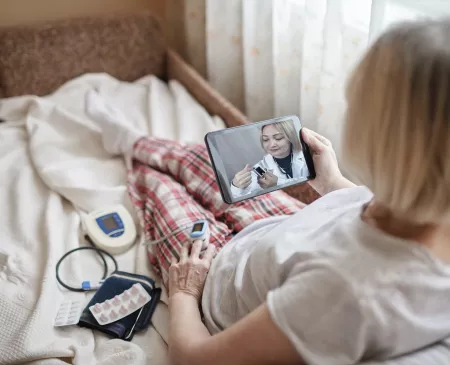What’s Trending: Hospital at Home Will Continue to Receive Payment Parity for Medicare FFS Patients for an Additional 2 Years
The Centers for Medicare and Medicaid Services’ (CMS) Acute Hospital Care at Home waiver was recently extended for 2 years via inclusion in the omnibus budget, which became law on December 29, 2022. With this most recent extension, hospital at home will have effectively secured Medicare Fee for Service (FFS) payment parity funding, from November 2020 through December 31, 2024—a period of more than 4 years.
Initially introduced in November 2020 as an innovative way to expand safe access to hospital care in the face of the pandemic, the CMS waiver has had relatively strong participation. As of January 31, 2023, CMS has approved 260 hospitals to provide inpatient-level care in patient’s homes, reimbursed by Medicare at parity with facility-based acute care.
While some programs have successfully scaled, many have remained in pilot mode or not yet admitted their first patient, anxiously awaiting regulatory guidance regarding the longevity of an important funding mechanism for the business model. This same uncertainty restrained many other health systems from pursuing the waiver at all. Notably, while many traditional providers have approached home-based care cautiously, many well-capitalized non-traditional players are positioning to serve this space, given the significant opportunity to redirect care from high-cost brick-and-mortar facilities.
The waiver extension is a catalyzing and symbolic event. For the first time, CMS has signaled that a longer-term, more certain hospital at home funding mechanism exists—one that is not directly tied to the public health emergency.
Why It Matters:
The CMS waiver represents something of a “walled garden” for health systems. Under the waiver, only acute care hospitals are eligible to bill and receive the Medicare FFS payment, for patients admitted from the Emergency Department (ED) or transferred from an inpatient unit. This funding mechanism creates the unique opportunity to extend hospital at home offerings from a purely value-based care context to a fee for service and value-based care context. But it is only for health systems. As a result, as long as the waiver exists, health systems have a major strategic advantage over non-health systems to deploy hospital at home services and rapidly scale up their programs, realizing sizeable return on investment and creating material barriers to entry for future prospective (likely non-health system) competitors. While there is still some risk of the unknown related to the long-term funding for hospital at home, the role of the home as a site of care is increasingly commonplace:
- The waiver extension represents more than 4 years of hospital at home funding at parity from CMS. Organizations that moved fast and early are now benefiting from funding that enables them to grow their programs in advantageous financial conditions and lay the foundation for other future use cases across the care-at-home ecosystem.
- The waiver has seen significant uptake: 260 hospitals—fully 5% of all acute care community hospitals—are already approved. Following the extension, many more hospitals are in the process of applying.
- Nearly 90% of health system executives say their organizations plan to pursue hospital at home in the next 5 years, and 39% say they expect to have implemented hospital at home in the next 5 years, according to a 2022 survey.
- The non-health system players are making big bets in the home, despite the funding advantage offered to health systems. CVS’ acquisition of Signify Health, United Healthcare’s acquisition of LHC Group, and Humana’s acquisition of Kindred at Home represent more than $20 billion of expenditure on home-based care businesses in 2022 alone.
The appeal of the home is not surprising, considering the well-validated outcomes of enhanced patient and family satisfaction, fewer healthcare-associated conditions, dramatic unit-cost savings and the ability to free up inpatient capacity. This sustained uptake helps build the case for making hospital at home a long-term setting even beyond the waiver period.
What’s Next:
Hospital-at-home is here to stay. It will continue to morph, evolve, scale, and advance, but there is mounting evidence that it will mature into a viable—and even vital—site of care in the future, as it has in other healthcare markets globally. Disrupters have already made significant investments and begun to capture value in the care-at-home market. Progressive health systems view it as a gateway to a comprehensive and multi-modal care-at-home ecosystem that unlocks a spectrum of new models of care, such as skilled nursing facility at home, palliative at home, ED at home, and primary care at home, not to mention transformed clinical service lines that seamlessly and proactively leverage the home as an integrated site of care. As more healthcare providers realize the many benefits of bringing care to the patient's home, it stands to become another standard option for appropriately selected patients to receive care safely, efficiently, and cost-effectively.
The passage of the omnibus bill provided a necessary path to secure a source of revenue. Now more than ever, every health system leader must critically evaluate the business case for hospital at home, as well as their broader care-at-home strategies for the future. Assessing the feasibility and requirements of launching these programs is the important first step. This includes defining the target clinical populations; identifying potential clinical, ancillary, and technology partners; and engaging key stakeholders to define care team structures, clinical pathways, and integrated, home-based workflows.
This is an exciting time in healthcare, and a call to action to expand access to truly patient-centered acute care.
Not sure where to get started? We’re here to help.
© 2025 The Chartis Group, LLC. All rights reserved. This content draws on the research and experience of Chartis consultants and other sources. It is for general information purposes only and should not be used as a substitute for consultation with professional advisors.




